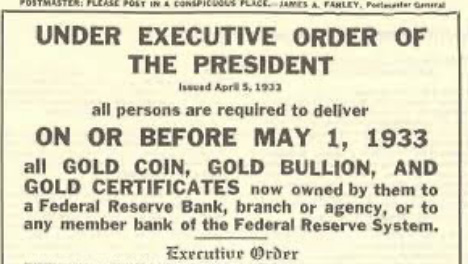Executive Order 6102 was issued by President Franklin D. Roosevelt on April 5, 1933, in the midst of the Great Depression. The order made it illegal for individuals and entities to own or hoard significant amounts of gold coins, gold bullion, or gold certificates.
The order required that all individuals turn in their gold to the Federal Reserve in exchange for paper currency at the prevailing price of $20.67 per ounce. The order exempted certain uses of gold, such as for industrial, professional, and artistic purposes.
The purpose of Executive Order 6102 was to combat the hoarding of gold during the Great Depression and to help stabilize the U.S. economy by increasing the money supply. By taking gold out of circulation, the government hoped to lower interest rates and encourage investment and borrowing.
Executive Order 6102 remained in effect until 1974 when President Gerald Ford signed a bill that legalized private ownership of gold
Significance of Executive Order 6102
The significance of Executive Order 6102 is two-fold. First, it had a significant impact on the U.S. economy during the Great Depression by increasing the money supply and helping to stabilize the economy. By taking gold out of circulation, the government was able to increase the amount of money in circulation, which made it easier for people and businesses to access credit and for the government to finance public works programs.
Second, the order represents a significant shift in U.S. monetary policy. Prior to Executive Order 6102, the U.S. was on the gold standard, which meant that the value of the U.S. dollar was tied to the value of gold. By taking the country off the gold standard and confiscating gold, the government was able to assert greater control over the money supply and monetary policy.
The order also had important implications for the way that the U.S. government interacts with its citizens. The government’s ability to seize private property in the interest of economic stability has been a topic of debate and controversy ever since. Additionally, Executive Order 6102 is sometimes cited as an example of government overreach and a violation of citizens’ property rights, particularly in the context of debates over monetary policy and the role of government in the economy.
